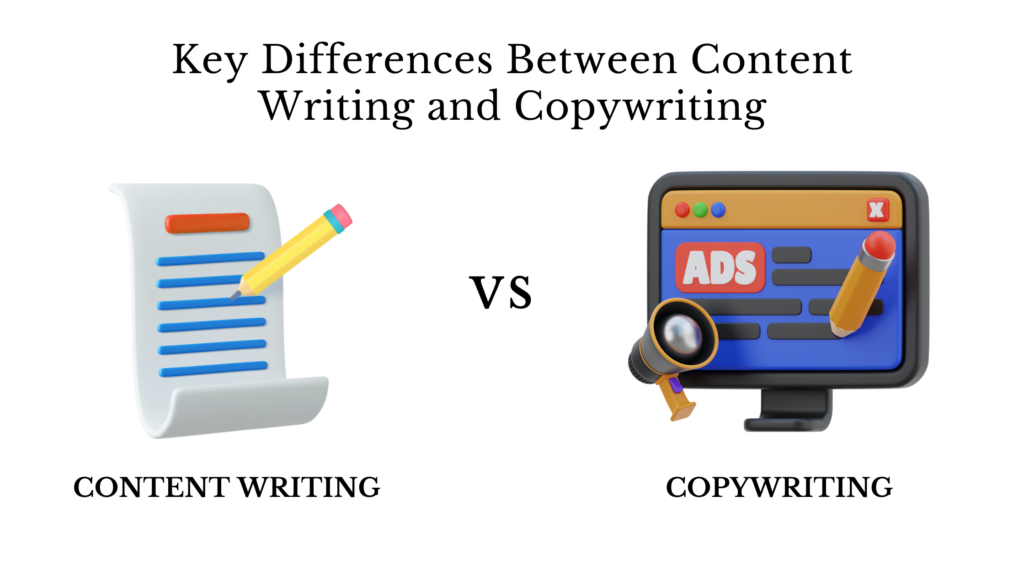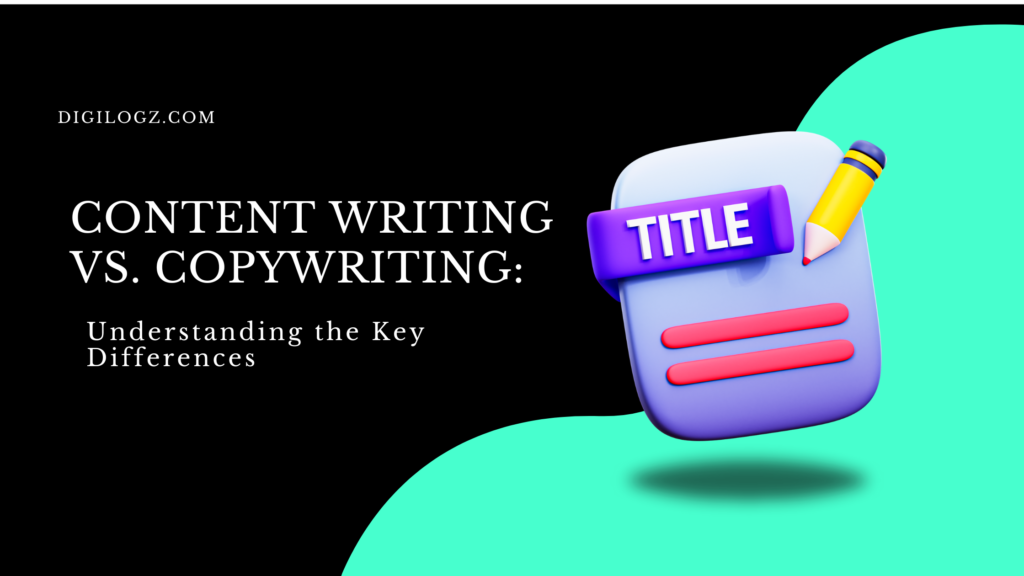Content Writing vs. Copywriting: Understanding the Key Differences
Introduction
In the ever-evolving digital landscape, both content writing and copywriting play crucial roles in marketing strategies. However, these two disciplines, though often used interchangeably, serve distinct purposes and require different skill sets. Understanding the differences between content writing and copywriting is essential for businesses aiming to leverage their strengths effectively. This blog provides a comprehensive guide to help you distinguish between these two forms of writing and make informed decisions for your marketing needs.

Section 1: What is Content Writing?
Definition of Content Writing
Content writing involves creating informative, engaging, and valuable content intended to educate, inform, or entertain the audience. This type of writing is typically used in blogs, articles, ebooks, whitepapers, and other long-form content pieces.
Examples of Content Writing
- Blog Posts: Articles published on blogs covering various topics to attract and engage readers. For example, a blog post on “10 Tips for Effective Time Management” provides valuable insights to readers looking to improve their productivity.
- Articles: Detailed pieces often found in online publications or magazines. An article in an online magazine might explore the impact of technology on education.
- Ebooks: In-depth, digital books used for marketing or educational purposes. For instance, a company might create an ebook on “The Ultimate Guide to Digital Marketing” to educate and capture leads.
- Whitepapers: Authoritative reports or guides on specific topics providing in-depth information. A whitepaper might analyze the benefits of adopting renewable energy sources for businesses.
Purpose of Content Writing
The primary purpose of content writing is to inform, educate, and entertain the audience. It aims to provide value, build brand authority, and foster long-term relationships with readers. For example, a blog post on health tips not only informs readers but also positions the author as an authority in the health and wellness niche.
Key Characteristics of Effective Content Writing
Effective content writing is characterized by its focus on SEO, informativeness, and engagement. Here are some key traits:
- SEO-Focused: Optimized for search engines to increase visibility and drive organic traffic. For instance, using relevant keywords and optimizing meta descriptions helps improve search engine rankings.
- Informative: Provides valuable and relevant information to the audience. An article detailing the steps to create a business plan offers practical advice to entrepreneurs.
- Engaging: Captivates the reader’s attention and encourages them to read further. Storytelling elements and engaging narratives can make content more compelling.
Content Writing Terminologies
- Content: Information or experiences shared through various media.
- Copy: Written material, typically for advertising or marketing.
- Content Strategy: Planning, development, and management of content.
- Content Marketing: Creating and sharing valuable content to attract and engage an audience.
- Editorial Calendar: A schedule of content topics and publishing dates.
- Audience: The group of people targeted by content.
- Persona: A fictional character representing a segment of the audience.
- Niche: A specialized segment of the market for content.
- Tone: The attitude or approach of the writing.
- Voice: The unique style of the writer or brand.
SEO (Search Engine Optimization) Terms
- Keyword: A word or phrase strategically used in content for SEO purposes.
- Long-Tail Keyword: A more specific, longer keyword phrase.
- Meta Description: A summary of a web page’s content for search engines.
- Alt Text: Descriptive text for images to improve accessibility and SEO.
- Backlink: A link from another website to your content.
- Internal Link: A link from one page to another within the same website.
- SERP (Search Engine Results Page): The page displayed by a search engine in response to a query.
- Organic Traffic: Visitors who come to a website through unpaid search results.
- CTR (Click-Through Rate): The percentage of users who click on a link versus those who see it.
- Bounce Rate: The percentage of visitors who leave a site after viewing only one page.
Content Types
- Blog Post: An article published on a blog.
- White Paper: An authoritative report or guide on a specific topic.
- Case Study: A detailed analysis of a particular instance or example.
- Ebook: A digital book used for marketing or educational purposes.
- Infographic: A visual representation of information or data.
- Press Release: An official statement issued to media outlets.
- Newsletter: A regular publication sent to subscribers.
- Social Media Post: Content created for social media platforms.
- Landing Page: A web page designed to convert visitors into leads or customers.
- Webinar: A seminar conducted over the internet.
Writing Techniques
- CTA (Call to Action): A prompt to encourage the reader to take a specific action.
- Hook: An attention-grabbing opening sentence or paragraph.
- Lead: The introductory section of a piece of content.
- Body: The main part of the content containing the core message.
- Conclusion: The closing part of the content that summarizes the key points.
- Headline: The title or heading of a piece of content.
- Subheadline: A secondary heading that provides more detail.
- Bullet Points: A list format used to present information.
- Byline: The author’s name and details at the beginning or end of a piece.
- Plagiarism: Using someone else’s work without proper attribution.
Performance Metrics
- Engagement: The level of interaction that content receives (likes, shares, comments).
- Conversion Rate: The percentage of visitors who complete a desired action.
- Impressions: The number of times content is displayed.
- Reach: The total number of unique users who see the content.
- ROI (Return on Investment): The measure of profitability of content efforts.
Tools and Platforms
- CMS (Content Management System): Software used to create and manage digital content (e.g., WordPress).
- Analytics: Tools and data that track and measure content performance (e.g., Google Analytics).
- SEO Tools: Software used to optimize content for search engines (e.g., Ahrefs, SEMrush).
- Social Media Scheduler: Tools that schedule and manage social media posts (e.g., Hootsuite).
- Grammar Checker: Tools that correct grammar and style (e.g., Grammarly).

Section 2: What is Copywriting?
Definition of Copywriting
Copywriting involves crafting persuasive, compelling, and concise text aimed at driving action. This type of writing is used in advertisements, sales pages, email marketing campaigns, and other promotional materials.
Examples of Copywriting
- Advertisements: Text specifically written for promotional ads. For example, an ad for a new smartphone might highlight its unique features and offer a limited-time discount.
- Sales Pages: Web pages designed to persuade visitors to make a purchase. A sales page for an online course might emphasize the benefits, include testimonials, and provide a clear call-to-action to enroll.
- Email Marketing: Promotional emails aimed at converting leads into customers. An email campaign might promote a holiday sale with a compelling subject line and persuasive content to encourage immediate purchases.
Purpose of Copywriting
The primary purpose of copywriting is to persuade, sell, and drive action. It focuses on compelling the audience to take a specific action, such as making a purchase, signing up for a newsletter, or clicking on a link.
Key Characteristics of Effective Copywriting
Effective copywriting is characterized by its ability to capture attention, evoke emotions, and prompt action. Here are some key traits:
- Compelling: Grabs the reader’s attention with powerful and persuasive language. For instance, an ad headline like “Unlock Your Potential with Our Online Course” immediately draws interest.
- Concise: Delivers the message in a clear and succinct manner. An email promoting a new product might succinctly outline its benefits and include a direct call-to-action.
- Action-Oriented: Includes strong calls-to-action to encourage immediate response. A landing page might feature a prominent button with text like “Get Started Now” to drive conversions.
Copywriting Terminologies
- Copy: The text used in marketing and advertising materials.
- Copywriter: A professional who writes copy.
- Creative Brief: A document outlining the strategy, target audience, and goals for a project.
- Brand Voice: The consistent personality and tone used by a brand in all communications.
- USP (Unique Selling Proposition): The key feature that distinguishes a product from its competitors.
- Tagline: A memorable phrase that captures the essence of a brand or product.
- Slogan: A short, catchy phrase used in advertising campaigns.
- Pitch: A proposal to persuade someone to accept an idea or buy a product.
Types of Copy
- Ad Copy: Text specifically written for advertisements.
- Sales Copy: Text designed to persuade someone to make a purchase.
- Direct Mail: Marketing materials sent directly to potential customers via postal mail.
- Web Copy: Text written for websites.
- Email Copy: Text written for email marketing campaigns.
- SEO Copy: Text written with search engine optimization in mind.
- Landing Page Copy: Text written for a landing page designed to convert visitors.
- Product Descriptions: Text describing the features and benefits of a product.
Writing Techniques
- Headline: The main title or attention-grabbing text at the beginning of a copy.
- Subheadline: Secondary text that provides more detail under the headline.
- Lead: The introductory part of the copy meant to hook the reader.
- Body Copy: The main text provides detailed information and persuasion.
- Call to Action (CTA): A prompt encouraging the reader to take a specific action.
- Bullet Points: A list format to present information clearly and concisely.
- A/B Testing: Comparing two versions of a copy to see which performs better.
- Copy Deck: A document that contains all the copy for a project.
- Hard Sell: A direct, forceful way of persuading someone to buy.
- Soft Sell: A subtle, gentle approach to persuasion.
Psychological Triggers
- Scarcity: Creating a sense of urgency by suggesting limited availability. For example, “Only 5 seats left” in an online course ad.
- Social Proof: Using testimonials or endorsements to build credibility. A landing page might feature customer reviews and success stories.
- Fear of Missing Out (FOMO): Leveraging the fear of missing an opportunity. An email might use “Last chance to save” to prompt immediate action.
- Authority: Establishing expertise or credibility to persuade. An ad might feature an expert endorsement or certification.
- Reciprocity: Offering something of value to encourage a return favor. A free trial offer in exchange for signing up for a newsletter.
- Emotion: Evoking emotions to connect with the audience and persuade. An ad for a charity might use emotional storytelling to encourage donations.
Metrics and Performance
- Conversion Rate: The percentage of people who take the desired action after seeing the copy.
- CTR (Click-Through Rate): The percentage of people who click on a link or CTA.
- Impressions: The number of times the copy is displayed.
- Engagement: Interactions with the copy, such as likes, shares, or comments.
- ROI (Return on Investment): The profitability of a copywriting campaign.
- Bounce Rate: The percentage of visitors who leave after viewing only one page.
Tools and Platforms
- CMS (Content Management System): Software used to manage digital content (e.g., WordPress).
- Copywriting Tools: Software that aids in creating and optimizing copy (e.g., Grammarly, Hemingway).
- Analytics Tools: Software that tracks and measures the performance of copy (e.g., Google Analytics).
- Email Marketing Platforms: Tools for creating and managing email campaigns (e.g., Mailchimp).
Legal and Ethical Terms
- Plagiarism: Using someone else’s work without proper attribution.
- FTC Guidelines: Regulations by the Federal Trade Commission regarding advertising and endorsements.
- Compliance: Ensuring copy adheres to legal and regulatory standards.
Industry-Specific Jargon
- B2B (Business-to-Business): Copy written for businesses selling to other businesses.
- B2C (Business-to-Consumer): Copy written for businesses selling directly to consumers.
- CTA Button: A clickable button in digital copy that prompts an action.
- Pain Points: Specific problems or needs of the target audience.
- Benefit: The advantage or positive outcome provided by a product or service.
- Feature: A characteristic or specification of a product or service.
- Value Proposition: A statement that explains why a customer should buy a product or service.

Section 3: Key Differences Between Content Writing and Copywriting
Purpose
- Content Writing: Primarily aims to educate or inform the audience. For example, a blog post on “The Benefits of a Plant-Based Diet” educates readers on health and environmental benefits.
- Copywriting: Primarily aims to persuade or sell to the audience. An advertisement for a new fitness program might highlight its unique features and benefits to encourage sign-ups.
Style and Tone
- Content Writing: Often more detailed, informative, and elaborate. A comprehensive guide on digital marketing might provide in-depth explanations and step-by-step instructions.
- Copywriting: Usually more concise, direct, and persuasive. A landing page promoting a webinar might use short, compelling text to encourage registrations.
Audience Engagement
- Content Writing: Engages through valuable information, storytelling, and detailed explanations. A case study detailing a company’s successful marketing campaign engages readers by showcasing real-world results.
- Copywriting: Engages through strong calls-to-action, emotional triggers, and persuasive language. An email campaign might use urgency and special offers to drive immediate action.
SEO and Keywords
- Content Writing: Heavily focused on SEO and keyword optimization to drive organic traffic. For example, a blog post on “SEO Tips for Small Businesses” uses targeted keywords to rank higher in search results.
- Copywriting: Uses SEO strategically but focuses more on emotional triggers and actions. A product description might include relevant keywords but prioritize persuasive language to encourage purchases.
Formats and Platforms
- Content Writing: Typically found in blogs, articles, newsletters, and other long-form content. An online magazine might feature an article on “The Future of Artificial Intelligence” providing detailed insights.
- Copywriting: Commonly used in advertisements, landing pages, product descriptions, and email campaigns. A social media ad might use a catchy headline and brief, persuasive text to promote a sale.

How to Decide Which One You Need
Business Goals
- Content Writing: Ideal for building brand authority, educating your audience, and providing value over time. A series of informative blog posts can establish a company as a thought leader in its industry.
- Copywriting: Best for driving sales, launching a product, or prompting immediate action. A compelling sales page can increase conversions and drive revenue.
Target Audience
Understanding your audience’s needs and preferences is crucial in deciding whether to use content writing or copywriting. For instance, a tech-savvy audience might appreciate detailed articles on new software, while a broader consumer base might respond better to direct, persuasive ads.
Marketing Strategy
Integrate both content writing and copywriting into your overall marketing strategy. For example, use content writing for blog posts to educate your audience and copywriting for landing pages to convert visitors into customers. A balanced approach ensures that you engage your audience at different stages of the buyer’s journey.
Skills Required for Content Writers and Copywriters
Content Writers:
- Strong research skills: Ability to gather and synthesize information from various sources.
- Ability to write long-form content: Capable of creating detailed and comprehensive pieces.
- Understanding of SEO: Knowledge of keyword research and on-page optimization techniques.
- Storytelling ability: Skill in crafting engaging narratives that resonate with readers.
Copywriters:
- Strong persuasive writing skills: Ability to craft compelling and convincing messages.
- Ability to write concise, impactful content: Proficiency in delivering the message effectively with fewer words.
- Understanding of marketing psychology: Insight into how to influence and persuade the audience.
- Strong calls-to-action: Expertise in prompting readers to take specific actions.
Jobs and Freelancers in Copywriting and Content Writing
Opportunities for Content Writers
Content writing offers a wide range of opportunities for freelancers and full-time positions. Here are some common job roles:
- Content Writer: Create blog posts, articles, and other long-form content.
- SEO Content Writer: Focus on writing content optimized for search engines.
- Technical Writer: Write manuals, guides, and other technical documents.
- Ghostwriter: Write content for clients under their name.
Freelance platforms like Flexijobs provide numerous opportunities for content writers to find projects and clients.
Opportunities for Copywriters
Copywriting also offers diverse opportunities for freelancers and full-time positions. Common job roles include:
- Copywriter: Craft persuasive and compelling copy for various marketing materials.
- SEO Copywriter: Write copy optimized for search engines while maintaining a persuasive tone.
- Advertising Copywriter: Create ad copy for print, digital, and broadcast media.
- Email Copywriter: Write compelling email campaigns to drive engagement and conversions.
Freelance platforms like Flexijobs are excellent resources for copywriters to find projects and clients.
Tips for Hiring the Right Professional
Assessing Skills and Portfolio
When hiring a content writer or copywriter, review their portfolio to assess their writing style, versatility, and effectiveness. Look for samples that align with your needs. For example, if you need blog posts, review their past blog articles to ensure quality and relevance.
Interview Questions
Ask questions that reveal their understanding of your industry, audience, and the specific writing skills required. For example:
- How do you approach keyword research and SEO?
- Can you provide examples of successful campaigns or content pieces you’ve written?
- How do you tailor your writing style to different audiences?
These questions help gauge their expertise and suitability for your specific requirements.
Conclusion
Understanding the key differences between content writing and copywriting is essential for making informed decisions that align with your business goals. While content writing focuses on educating and providing value over time, copywriting aims to persuade and drive immediate action. By evaluating your needs and marketing objectives, you can effectively integrate both approaches to achieve optimal results.
We’d love to hear about your experiences with content writing and copywriting. Share your thoughts or ask questions in the comments below. If you need help with your content or copywriting needs, feel free to reach out for a free consultation or explore our resources.
FAQs
How do I decide whether to use content writing or copywriting for my business needs?
Your choice should align with your business goals and audience preferences. Use content writing to build brand authority, educate your audience, and provide long-term value. Opt for copywriting when you need to drive sales, launch a product, or prompt immediate action. A balanced strategy that incorporates both can effectively engage your audience throughout their buying journey.
What skills are essential for content writers and copywriters?
Content writers should possess strong research skills, the ability to write long-form content, an understanding of SEO, and storytelling abilities. Copywriters need strong persuasive writing skills, the ability to write concise and impactful content, an understanding of marketing psychology, and expertise in creating strong calls-to-action.
How does SEO differ in content writing and copywriting?
Content writing heavily focuses on SEO and keyword optimization to drive organic traffic and improve search engine rankings. This involves using relevant keywords, creating high-quality content, and optimizing meta descriptions. Copywriting uses SEO strategically but prioritizes emotional triggers and calls-to-action to persuade and convert the audience.
Can one person be both a content writer and a copywriter?
Yes, it is possible for one person to excel in both content writing and copywriting, especially if they have a versatile skill set and a deep understanding of both disciplines. However, it often requires a clear distinction in approach and mindset, as the goals and techniques for content writing and copywriting can differ significantly.



